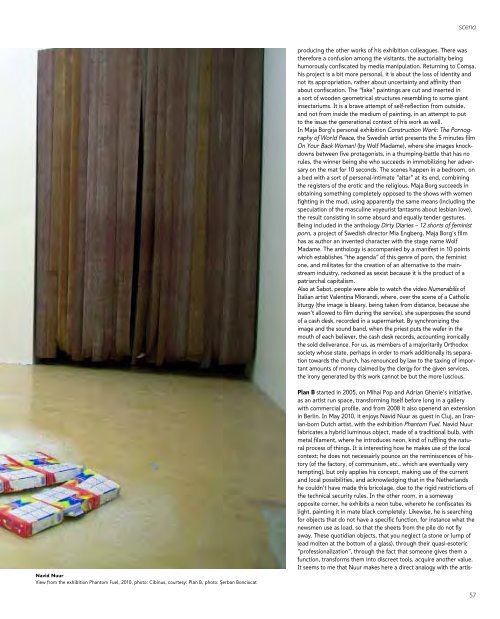You also want an ePaper? Increase the reach of your titles
YUMPU automatically turns print PDFs into web optimized ePapers that Google loves.
scena<br />
producing the other works of his exhibition colleagues. There was<br />
therefore a confusion among the visitants, the auctoriality being<br />
humorously confiscated by media manipulation. Returning to Comøa,<br />
his project is a bit more personal, it is about the loss of identity and<br />
not its appropriation, rather about uncertainty and affinity than<br />
about confiscation. The “fake” paintings are cut and inserted in<br />
a sort of wooden geometrical structures resembling to some giant<br />
insectariums. It is a brave attempt of self-reflection from outside,<br />
and not from inside the medium of painting, in an attempt to put<br />
to the issue the generational context of his work as well.<br />
In Maja Borg’s personal exhibition Construction Work: The Pornography<br />
of World Peace, the Swedish artist presents the 5 minutes film<br />
On Your Back Woman! (by Wolf Madame), where she images knockdowns<br />
between five protagonists, in a thumping-battle that has no<br />
rules, the winner being she who succeeds in immobilizing her adversary<br />
on the mat for 10 seconds. The scenes happen in a bedroom, on<br />
a bed with a sort of personal-intimate “altar” at its end, combining<br />
the registers of the erotic and the religious. Maja Borg succeeds in<br />
obtaining something completely opposed to the shows with women<br />
fighting in the mud, using apparently the same means (including the<br />
speculation of the masculine voyeurist fantasms about lesbian love),<br />
the result consisting in some absurd and equally tender gestures.<br />
Being included in the anthology Dirty Diaries – 12 shorts of feminist<br />
porn, a project of Swedish director Mia Engberg, Maja Borg’s film<br />
has as author an invented character with the stage name Wolf<br />
Madame. The anthology is accompanied by a manifest in 10 points<br />
which establishes “the agenda” of this genre of porn, the feminist<br />
one, and militates for the creation of an alternative to the mainstream<br />
industry, reckoned as sexist because it is the product of a<br />
patriarchal capitalism.<br />
Also at Sabot, people were able to watch the video Numerabilis of<br />
Italian artist Valentina Miorandi, where, over the scene of a Catholic<br />
liturgy (the image is bleary, being taken from distance, because she<br />
wasn’t allowed to film during the service), she superposes the sound<br />
of a cash desk, recorded in a supermarket. By synchronizing the<br />
image and the sound band, when the priest puts the wafer in the<br />
mouth of each believer, the cash desk records, accounting ironically<br />
the sold deliverance. For us, as members of a majoritarily Orthodox<br />
society whose state, perhaps in order to mark additionally its separation<br />
towards the church, has renounced by law to the taxing of important<br />
amounts of money claimed by the clergy for the given services,<br />
the irony generated by this work cannot be but the more luscious.<br />
Navid Nuur<br />
View from the exhibition Phantom Fuel, 2010, photo: Cibinus, courtesy: Plan B, photo: Øerban Bonciocat<br />
Plan B started in 2005, on Mihai Pop and Adrian Ghenie’s initiative,<br />
as an artist run space, transforming itself before long in a gallery<br />
with commercial profile, and from 2008 it also openend an extension<br />
in Berlin. In May 2010, it enjoys Navid Nuur as guest in Cluj, an Iranian-born<br />
Dutch artist, with the exhibition Phantom Fuel. Navid Nuur<br />
fabricates a hybrid luminous object, made of a traditional bulb, with<br />
metal filament, where he introduces neon, kind of ruffling the natural<br />
process of things. It is interesting how he makes use of the local<br />
context; he does not necessairly pounce on the reminiscences of history<br />
(of the factory, of communism, etc., which are eventually very<br />
tempting), but only applies his concept, making use of the current<br />
and local possibilities, and acknowledging that in the Netherlands<br />
he couldn’t have made this bricolage, due to the rigid restrictions of<br />
the technical security rules. In the other room, in a someway<br />
opposite corner, he exhibits a neon tube, whereto he confiscates its<br />
light, painting it in mate black completely. Likewise, he is searching<br />
for objects that do not have a specific function, for instance what the<br />
newsmen use as load, so that the sheets from the pile do not fly<br />
away. These quotidian objects, that you neglect (a stone or lump of<br />
lead molten at the bottom of a glass), through their quasi-esoteric<br />
“professionalization”, through the fact that someone gives them a<br />
function, transforms them into discreet tools, acquire another value.<br />
It seems to me that Nuur makes here a direct analogy with the artis-<br />
57














